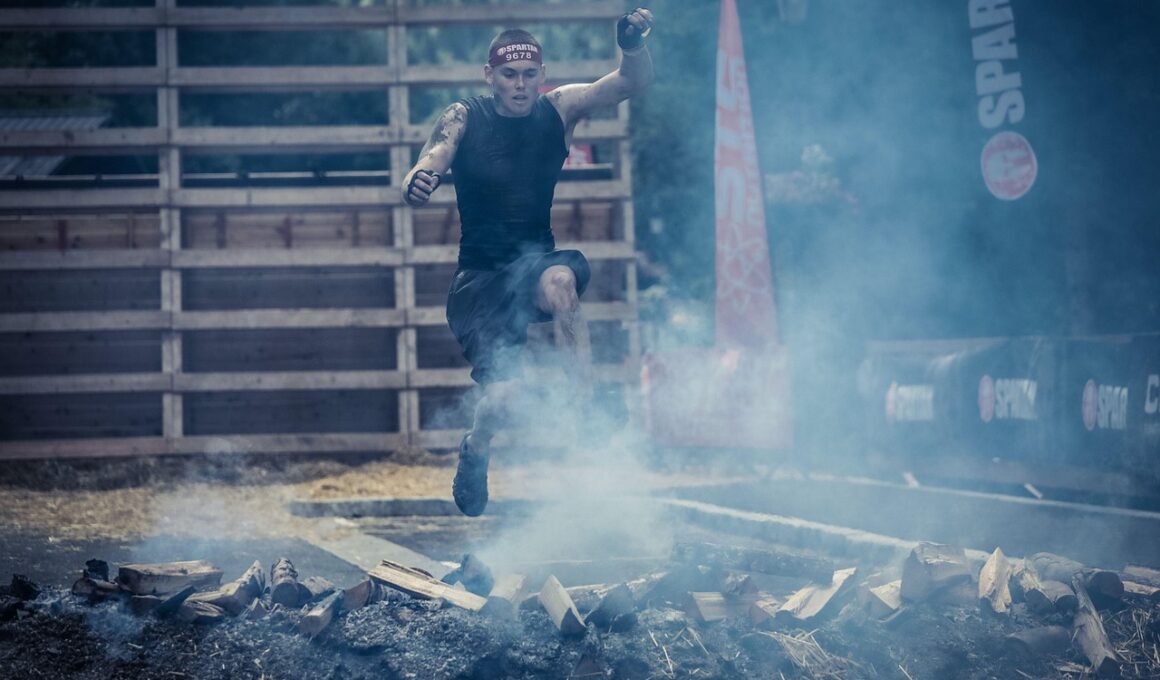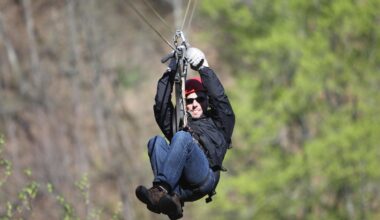Strength Training Techniques to Avoid OCR Injuries
Obstacle Course Racing (OCR) challenges athletes both physically and mentally, emphasizing the importance of effective strength training. A well-structured strength program can drastically reduce the risk of injuries typically encountered during these intense events. Increasing overall strength enhances performance, but it also prepares your body to withstand the various rigors of OCR competitions. This preparation is crucial for overcoming obstacles, ranging from climbing walls to navigating heavy terrains. Focus should be placed on functional exercises that mimic the movements you encounter in an OCR. This could include exercises like kettlebell swings, box jumps, and tire flips. By incorporating compound movements, you not only build muscle but also improve balance and coordination. Additionally, using your own body weight for resistance can be highly effective, particularly with exercises such as push-ups and pull-ups. These moves engage multiple muscle groups and develop strength across your entire body. Always ensure proper technique to prevent injuries. Emphasizing core stability helps sustain your body during challenging physical tasks. As you train, listen to your body and adjust your regimen according to your individual needs, helping to maintain a healthy training environment for yourself.
Proper warm-up routines play a vital role in any strength training program aimed at preventing injuries in OCR. Before you commence any sort of intense workout, engage in dynamic stretching to warm up your muscles effectively. This involves movements that promote blood circulation throughout your body while increasing flexibility in your joints. Exercises such as leg swings, arm circles, and hip openers should become staples in your warm-up routine. Additionally, incorporating light cardio for about 10-15 minutes can further prepare your body. This could be running in place or jumping rope. Warm-ups should focus on mimicking the activities you will perform, enhancing your preparation. Following the warm-up, gradually increase the intensity of your workout rather than starting at peak levels. After your main workout, don’t forget to cool down properly. Implement static stretching to promote flexibility and speed up recovery after intense training sessions. Stronger muscles are more resilient to injuries, meaning your risk diminishes significantly. Furthermore, being mindful of your form not only helps in the prevention of injuries but enhances your overall training experience, allowing for better performance during OCR events.
Specific Strength Training Exercises
Incorporating specific strength training exercises that target the major muscle groups is vital for OCR success and injury prevention. Focus on lower body exercises such as squats, lunges, and deadlifts to build powerful legs that will help you navigate obstacles efficiently. These movements cultivate both strength and stability, essential for maintaining control during races. Upper body workouts are equally important, as they are critical for tasks requiring pulling, such as climbing ropes or completing monkey bars. Exercises like rows, bench presses, and overhead presses build muscle but also enhance functional stability. Don’t overlook core training, as a strong core supports almost every movement in OCR. Plank variations, Russian twists, and medicine ball slams can bolster your body’s core strength drastically. Additionally, incorporating flexibility and mobility workouts, such as yoga, ensures a balanced approach to fitness, increasing the range of motion in your movements. Using equipment like resistance bands and stability balls can also enhance these exercises while preventing injuries. Regular strength assessments help build awareness of your progress, allowing you to adapt your training to ensure continued improvement and injury prevention as you prepare for OCR events.
Incorporating endurance training is also crucial for injury prevention in OCR. Strength alone isn’t sufficient; athletes must have stamina to endure the multi-faceted demands of obstacle racing. Integrating cardiovascular exercises like running, cycling, or swimming into your routine builds this stamina effectively. Aim for at least 2-3 endurance sessions weekly, allowing your body to adapt and recover from the varied stressors it experiences during competitions. Moreover, try adding interval training to your program. High-Intensity Interval Training (HIIT) precisely simulates the on-off effort needed throughout an OCR. Not only does it improve cardiovascular fitness, but it also enhances your ability to recover quickly from exertion. This training balance forms a solid base for your strength workouts. Ensuring that you don’t neglect recovery also plays a crucial role in injury prevention. Adequate rest between workouts allows muscles to heal and grow stronger. Combine proper nutrition with sleep to expedite recovery rates. Hydration should also be a priority during both training and racing. By providing your body with enough fluids, you improve performance and reduce fatigue, enhancing your overall resilience during races.
The Importance of Cross-Training
Cross-training serves as an excellent method to prevent injuries while building strength for OCR events. Engaging in diverse physical activities helps develop different muscle groups without overstressing specific areas. This variability can mitigate the risk of chronic injuries caused by repetitive motions during training. Activities such as swimming, cycling, or even yoga allow muscle recovery while still enhancing your cardiovascular and muscular endurance. Additionally, cross-training keeps your workouts fresh and exciting, reducing mental burnout. Balance strength training with aerobic exercises, allowing your body flexibility in recovery times without compromising performance. Furthermore, consider incorporating plyometric exercises into your training regimen. These explosive movements train your muscles to exert maximum force in short intervals, improving both strength and speed. Examples include box jumps and burpees. By integrating a well-rounded program that includes cross-training, your body adapts more effectively and allows for better overall performance in races. In every aspect of your training, confidence is essential. The variety in your regimen helps motivate you while preparing your body for unforeseen challenges in OCR. This preparation ultimately contributes significantly to fewer injuries and greater enjoyment in your racing experience.
Maintaining a proper nutrition plan is equally important for injury prevention in OCR training. Athletes must fuel their bodies with a balanced diet rich in proteins, carbohydrates, and healthy fats. These nutrients play essential roles in muscle recovery and energy production. High-quality protein sources, such as lean meats, legumes, and dairy, promote muscle regeneration, vital after intense workouts. Carbohydrates provide the energy needed for endurance activities, so sources like fruits, vegetables, and whole grains should be included in ample amounts. Healthy fats are equally important, helping protect joints and support nutrient absorption. Moreover, consider planning your meals around your training schedules. Consuming a small meal or snack an hour before workouts can optimize energy levels, while a post-workout recovery meal can accelerate healing. Hydration plays a role here too; ensure you consume adequate water throughout the day, especially pre- and post-training. Sometimes, athletes neglect these nutrition essentials, but they are key components in avoiding injuries. If you struggle with meal planning, seeking guidance from a registered dietitian can streamline the process. Remember that nutrition impacts not just performance but recovery and endurance. Adopting a holistic approach helps you reach peak performance during OCR events.
Monitoring Your Progress
Regularly monitoring your progress is crucial to injury prevention as you prepare for OCR races. Tracking workouts and your overall physical condition helps to identify areas requiring adjustment in your training. Maintain a training journal or use fitness apps that allow for recording specific exercises, sets, and progress over time. This can reveal patterns that may indicate potential injuries. Additionally, regularly perform fitness assessments to check your strength levels and adjust your workouts accordingly. Such evaluations offer insights into which areas might need more focus, ensuring all muscle groups are developing evenly. With injury prevention as the priority, establish a system for reviewing your nutrition and recovery strategies too. Recovery includes not just rest but also assessing the quality of sleep and nutrition. Engage with fitness professionals if possible, as they can provide useful feedback on your form and progress. Create a supportive network with fellow OCR athletes or coaches to share experiences and insights that aid recovery. Prioritizing evaluation helps detect underlying issues before they become significant injuries. In this way, you’ll stay focused on achieving your OCR goals while maintaining your health and fitness.
This proactive approach to strength training, nutrition, and recovery produces significant physical improvements while minimizing injuries. As you build upon the foundation gained through these techniques, you empower your body to pursue the challenges presented by obstacle course racing successfully. Consistency is key; an individualized program built upon strength training, endurance, cross-training, and proper nutrition fosters resilience. By committing to this multifaceted training strategy, you improve your physical preparation for races while significantly reducing your likelihood of injury. Celebrate your progress, however small it may seem, as it ultimately inspires you to stay dedicated to your goals. Always listen to your body and respect its limits, making adjustments as necessary. This thoughtful approach guarantees continuous improvement and satisfaction throughout your OCR journey. By embracing these principles, you position yourself to thrive in ever-challenging environments, inspiring others on similar journeys. It’s not solely about personal achievement; sharing knowledge through communities can elevate awareness around injury prevention and fitness development while participating in OCR. Ultimately, through mutual support, athletes can flourish together at every stage, creating a culture of health and resilience in the world of obstacle course racing.


